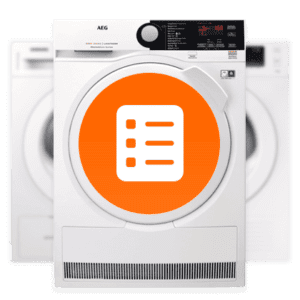Different types of dryers
If you want to buy a new dryer, it is important to know that there are 3 types of dryers; the (air) extractor dryer, condenser dryer and heat pump dryer. Of these, the air vent dryer is a bit the odd one out. These are often older models and they operate a lot less energy efficient than their more modern competitors. What’s more, airflow dryers are characterized by the way the moisture is removed. The moist air is led outside with a hose through a window or a hole in the wall. Because the energy consumption of the extractor dryer is so high, we do not recommend this type of dryer. Airflow dryers are often cheaper to buy, but because they use so much energy, they end up costing you more. For that reason, we will focus more on condenser dryers and heat pump dryers in this article.
Condensator dryer vs heat pump dryer; the differences
Both types of dryers basically do the same thing; they dry your laundry after washing. They also remove the moisture that is extracted from your clothes in the same ways. Both heat pump and condenser dryers have two ways to deal with the moisture in the air:
- The condensation is collected in a tank. This is a condensate tray, built into the dryer, that you need to empty after each drying cycle.
- You connect the dryer to the water drain. By connecting the dryer to the drain, you don’t have to worry about it at all – but it is important that you have a drain in the room where you will put the dryer.
Longside these similarities, there are some major differences between the condenser dryer and the heat pump dryer.
Energy consumption
The condenser dryer is more energy efficient than the clothes dryer, but the heat pump dryer is by far the most energy efficient. Heat pump dryers are often more expensive to buy, but because they are so economical in drying, they are cheaper in the long run. On average, a dryer lasts about 12 years. A heat pump dryer in energy class A+++ (the most energy-efficient) can save you up to 75 euros a year on energy bills – compared to a condenser dryer with energy label B.
Effect on your laundry
Because a heat pump dryer dries your clothes at a lower temperature than a condenser dryer, your clothes last longer. This is because a heat pump dryer works with a heat pump and a refrigerant, while a condenser dryer dries with a heating element. The hot air can be harmful to your clothes, causing them to shrink or wear out.
Drying time
Because the heat pump dryer dries at a low temperature, however, it does take longer for all the clothes in the drum to dry. A heat pump dryer with energy label A+++ takes on average 2 hours and 45 minutes to dry a full load, while a condenser dryer takes only 2 hours and 45 minutes.
Wash dryers by family size
When looking for a new dryer, one of the most important features to look for is the fill weight. This is because it determines the size of the dryer’s drum, and therefore how much laundry can fit in it at one time. It is important to get a dryer that is in good proportion to the size of your household. If it is too big, it will use more energy than is necessary to cope with the amount of laundry. If it is too small, you will have to dry more often each week, which is not very economical either.
If you are having trouble estimating how big you need your new dryer to be, we recommend that you look at the fill weight of the washing machine. By choosing a dryer with at least as many loads as your washing machine, you will always be able to fit all of your wet laundry into the dryer. Are you buying a new washing machine and tumble dryer? Check out the following chart to see which clothes dryer is right for your family size.
- a 1 or 2 person household: a 6 or 7kg dryer.
- a 3 or 4 person household: an 8kg dryer.
- a household of 5 or more people: a 9kg clothes dryer.
Wash dryers with and without an exhaust hose
The exhaust dryer uses an exhaust hose to direct the warm air out through a window or hole in the wall. However, if you need a new dryer, we do not recommend these dryers because the energy consumption is very high. Condensation dryers are more economical, but the heat pump dryer is the best. These last two types of dryers have two options for getting rid of the condensation; either a reservoir or a hose to the water outlet.
If you don’t have an outlet in your laundry room, the moisture can be collected in a reservoir. This requires a little more attention and maintenance, as you will have to empty it into the sink after each drying cycle. If you do have a drain in the room of your dryer, we recommend this option. This way you don’t have to worry about the moisture of your dryer at all.

